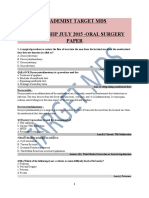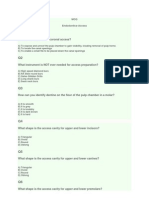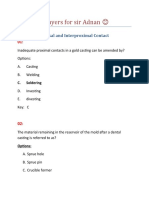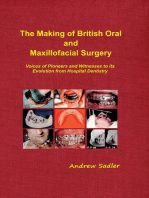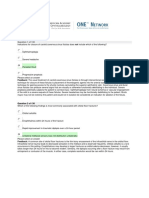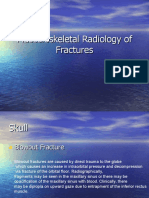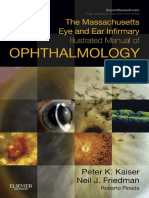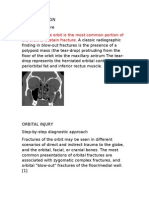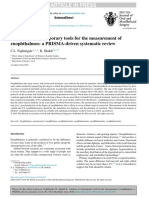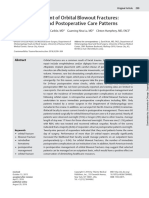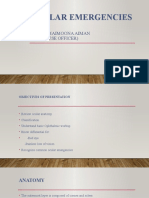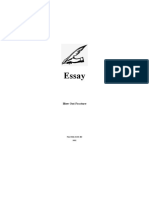Traumatology MCQ
Traumatology MCQ
Uploaded by
وليد خالدCopyright:
Available Formats
Traumatology MCQ
Traumatology MCQ
Uploaded by
وليد خالدOriginal Title
Copyright
Available Formats
Share this document
Did you find this document useful?
Is this content inappropriate?
Copyright:
Available Formats
Traumatology MCQ
Traumatology MCQ
Uploaded by
وليد خالدCopyright:
Available Formats
TRAUMATOLOGY - م١:٠٦ ،٢٠١٩/١١/١٤
Home Who we are Video Library Plan
Archives
TRAUMATOLOGY
1. When a mandibular fracture is transferred to an emergency room, under what is mandibular fractur
treated?
a) Primary survey
b) Secondary survey
c) Primary survey with IMF
d) Resuscitation room
Ans: B
2. A patient with maxillofacial injuries should be carried in
a) supine position
b) lateral position
c) prone position
d) sitting position
Ans: B
3. The presence of tension pneumothorax should be considered in patients who has feature as
a) Development of severe respiratory distress with decreased breath sounds, hyper resonance on one
chest
b) Development of severe respiratory distress and deviation of trachea to the side involved
c) Patient becomes acutely ill, with collapsed neck veins.
http://www.mdsclasses.com/lesson/traumatology/ ٥١ ﻣﻦ١ ﺻڡﺤﺔ
﮲
TRAUMATOLOGY - م١:٠٦ ،٢٠١٩/١١/١٤
d) All of the above
Ans: A
4. Raised intracranial pressure following a maxillofacial injury
a) is a normal finding
b) is typically associated with an increase in the heart rate
c) is typically associated with an increase in the blood pressure
d) usually subsides spontaneously
Ans: C
5. Not true about avulse injuries
a) Handguns project low caliber and thus low mass bullets at low velocity.
b) Rifle propels both low and high caliber bullets and thus low and high mass projectile yet at high velo
c) Shotgun projects multiple low caliber and therefore low mass pellets at low velocity.
d) Explosion fragments are propelled at low velocity and temporary cavity is formed.
Ans: D
6. In a patient of head injury which is more important to note first:
a) Pupillary light reflex
b) Pupillary size
c) Corneal reflex
d) Ability to open eye
Ans: D
7. Which of the following is an immediate danger to a patient with severe facia! Injuries
a) Bleeding
b) Associated fracture spine
http://www.mdsclasses.com/lesson/traumatology/ ٥١ ﻣﻦ٢ ﺻڡﺤﺔ
﮲
TRAUMATOLOGY - م١:٠٦ ،٢٠١٩/١١/١٤
c) Infection
d) Respiratory obstruction
Ans: D
8. Which of the following always indicates obstruction to the airway?
a) Slow pounding pulse
b) Stertorous breathing
c) Increase in pulse rate
d) Decrease in blood pressure
Ans: B
9. The head tilt procedure while dealing with an unconscious patient in dental chair is done to ensure
a) patent airway
b) blood circulation to the brain
c) to clear the foreign body obstacle
d) to relieve spasm of respiratory muscles
Ans: A
10. Of the following, which is the immediate treatment for a patient with comminuted fracture and in th
of shock?
a) Ringer’s lactate solution by IV route
b) Normal saline by IV route
c) Blood transfusion
d) Plasma expanders
Ans: A
11. Definitive management of maxillofaciai trauma after trauma can be delayed up to what time withou
http://www.mdsclasses.com/lesson/traumatology/ ٥١ ﻣﻦ٣ ﺻڡﺤﺔ
﮲
TRAUMATOLOGY - م١:٠٦ ،٢٠١٩/١١/١٤
substantially compromising the outcome?
a) Should be done 5-7 days of admission
b) Can be delayed up to 2 weeks
c) Should be performed immediately after admission
d) None
Ans: B
12. Clinical sign that is always positive in bone fracture is
a) Crepitus
b) Tenderness
c) Abnormal mobility
d) All of the above
Ans: B
13. Direct impact on the bone will produce a
a) Transverse fracture
b) Oblique fracture
c) Spiral fracture
d) Comminuted fracture
Ans: A
14. Green stick fractures are most common with a_________
a) Older people
b) Adult
c) Children
d) Soldiers
Ans: C
http://www.mdsclasses.com/lesson/traumatology/ ٥١ ﻣﻦ٤ ﺻڡﺤﺔ
﮲
TRAUMATOLOGY - م١:٠٦ ،٢٠١٩/١١/١٤
15. Osteomyelitis is most commonly associated with__________
a) compound fractures
b) comminuted fractures
c) green stick fractures
d) telescopic fracture
Ans: A
16. Principles in treating fractures include
a) Reduction of fracture
b) Fixation of fracture and restoration of occlusion
c) Immobilisation
d) All of the above
Ans: D
17. During panfacial fractures the structures that are reconstructed first are
a) Outer bone segments of the frame
b) Bones inside the framework
c) Maxilla always
d) Mandible always
Ans: A
18. The most common site of fracture of the mandible is the
a) body
b) angle
c) symphysis
http://www.mdsclasses.com/lesson/traumatology/ ٥١ ﻣﻦ٥ ﺻڡﺤﺔ
﮲
TRAUMATOLOGY - م١:٠٦ ،٢٠١٩/١١/١٤
d) condyle
Ans: B
19. The weakest part and most vulnerable part for fracture in the mandible is
a) Ramus of mandible
b) Condylar neck
c) Angle of the mandible
d) Region of the canine tooth
Ans: B
20. Bones usually fracture at the site of
a) Compressive strain
b) Tensile strain
c) Rich blood supply
d) Thin periosteal covering
Ans: B
21. In case of suspected #, area demonstrating increase in radiopacity is described by:
a) Separation sign
b) Overlapping sign
c) Corman’s sign
d) Battle’s sign
Ans: B
22. Orbital blow out fracture is best seen in?
a) Reverse town
b) Waters view
c) PA view
d) Submentovertex
http://www.mdsclasses.com/lesson/traumatology/ ٥١ ﻣﻦ٦ ﺻڡﺤﺔ
﮲
TRAUMATOLOGY - م١:٠٦ ،٢٠١٩/١١/١٤
Ans: B
23. The radiographic view of choice for diagnosing horizontally favorable/unfavorable # is:
a) OPG
b) Occlusal
c) Lateral Oblique view
d) Transpharyngeal
Ans: C
24. Condylar neck fracture best detected in
a) Submentovertex projection
b) Water’s projection
c) Posterio anterior skull projection
d) Reverse towne projection
Ans: D
25. Of the following which is almost pathognomonic of a mandibular fracture
a) Deep laceration near the area of trauma and paresthesia
b) Ecchymosis in the lingual sulcus and dearranged occlusion
c) Anterior open bite and deviation of the mandible on opening
d) None of the above are correct. There is no pathogenic feature of mandibular fracture
Ans: B
26. All are features of mandibular fracture except:
a) Malocclusion
b) Paresthesia of lower lip
c) Fractured ends are prevented from dislocation by masticatory muscles
http://www.mdsclasses.com/lesson/traumatology/ ٥١ ﻣﻦ٧ ﺻڡﺤﺔ
﮲
TRAUMATOLOGY - م١:٠٦ ،٢٠١٩/١١/١٤
d) Are usually compound
Ans: C
27. The proximal segment of mandible angle fracture usually displaced in
a) Anterior and superior
b) Posterior and interior
c) Interior only
d) Posterior and superior
Ans: A
28. In a patient with bilateral dislocated fractures of the necks of the mandibular condyles, one can expe
following clinical signs
a) Anterior open bite
b) Inability to protrude the mandible
c) Inability to bring posterior molars into contact
d) A&B
Ans: D
29. Which of the following are most complicated fractures?
a) Symphysis
b) Body
c) Condyle
d) Angle
Ans: C
30. “Burst” type # of mandibular condyle seen in pediatrlc patient is due to.
a) Increased vascularity and thinner cortical plates
http://www.mdsclasses.com/lesson/traumatology/ ٥١ ﻣﻦ٨ ﺻڡﺤﺔ
﮲
TRAUMATOLOGY - م١:٠٦ ،٢٠١٩/١١/١٤
b) More pronounced articular eminence
c) Relatively small facial size with respect to more prominent skull of the child
d) Decreased force involved in most childhood injuries
Ans: A
31. A 7 year old boy presented with fracture of left sub condylar region with occlusion undisturbed, the
treatment would be
a) Immobilization for 7 days
b) Immobilization for 14 days with intermittent active opening
c) No immobilization with restricted mouth opening for 10 days
d) No immobilization and no active treatment
Ans: D
32. In children fracture mandible which has not been perfectly reduced but has become firm with slight
imperfection, the choice of the management would be
a) Arch bar and elastric traction
b) Accept the slight imperfection and allow for later remodeling
c) Refracture and plating
d) Refracture and interosseous wiring
Ans: B
33. An adult patient sustained a subcondylar fracture on the left side. Clinically it is seen that there is
a) Moderate intraoral bleeding
b) Trismus and bilateral crepitus
c) Deviation of the mandible to the right on protrusion
d) Inability to deviate the mandible to the right on opening
Ans: D
http://www.mdsclasses.com/lesson/traumatology/ ٥١ ﻣﻦ٩ ﺻڡﺤﺔ
﮲
TRAUMATOLOGY - م١:٠٦ ،٢٠١٩/١١/١٤
34. The muscle, under the influence of which, the superior fragment of condyle, in a condylar neck # is
displaced anteriorly and medially is
a) Medial Pterygoid
b) Lateral Pterygoid
c) Masseter
d) Temporalis
Ans: B
35. In case of pure symphysis fracture of mandible, fracture segments are usually displaced
a) Lingually & downward by the pull of Genioglossus mylohyoid muscles.
b) Mainly lingually and lingual & downward movement due to the pull of Geniohyoid & myohyoid musc
c) Mainly upward movement. Lingual and upward movement due to the pull of Geniohyoid and myloh
muscle.
d) None of the above are correct. A little (or) no displacement occur.
Ans: D
36. Posterior displacement of the fractured anterior segment in the bilateral fracture of the mandible in
canine region is due to the action of the
a) Thyrohyoid, genioglossus and geniohyoid
b) Mylohyoid, genioglossus and geniohyoid
c) Geniohyoid and genioglossus and anterior belly of digastric muscles
d) Mylohyoid, geniohyoid and thyrohyoid muscle
Ans: C
37. A fractured coronoid process of mandible displaces upwards by the action of following muscle
a) Buccinator
http://www.mdsclasses.com/lesson/traumatology/ ٥١ ﻣﻦ١٠ ﺻڡﺤﺔ
﮲
TRAUMATOLOGY - م١:٠٦ ،٢٠١٩/١١/١٤
b) Lateral Pterygoid
c) Mylohyoid
d) Temporalis
Ans: D
38. Which of the following is seen with guardsman fracture associated with bilateral condylar fractures
a) Increased intercanthal distance
b) Increased interpupillary distance
c) Increased gonion gnathion distance
d) Increased interangular distance
Ans: D
39 Fracture most commonly resulting in widening of face is?
a) Parasymphyseal and symphyseal region fracture without condylar fracture
b) Parasymphyseal and symphyseal region fracture with condylar fracture
c) Zygomaticomaxillary complex fracture
d) Cranio-facial disjunction fracture
Ans: B
40. Fracture of mandible not involving dental arch is treated by
a) Open reduction
b) Closed reduction
c) No treatment required
d) None of the above
Ans: A
http://www.mdsclasses.com/lesson/traumatology/ ٥١ ﻣﻦ١١ ﺻڡﺤﺔ
﮲
TRAUMATOLOGY - م١:٠٦ ،٢٠١٩/١١/١٤
41. A displaced, unfavorable fracture in the mandibular angle region is a potentially difficult fracture to
because of
a) Injury to neurovascular bundle
b) Malocclusion secondary to injury
c) Distraction of fracture segments by muscle pull
d) Increased density of bone in this region of mandible
Ans: C
42. Unfavorable fracture of angle of mandible is best treated by
a) Closed reduction with IMF
b) Closed reduction with cap splint
c) Open reduction with bone plate fixation
d) Circummandibular wiring
Ans: C
43 The splint which is most commonly used in dentulous mandibular fracture is
a) Gunning splint
b) Cap splint
c) Ribbon splint
d) All of these
Ans: B
44. How many weeks of fixation are required for fracture mandible?
a) 8-10 weeks
b) 6-8 weeks
c) 4-6 weeks
d) 2-4 weeks
Ans: C
http://www.mdsclasses.com/lesson/traumatology/ ٥١ ﻣﻦ١٢ ﺻڡﺤﺔ
﮲
TRAUMATOLOGY - م١:٠٦ ،٢٠١٩/١١/١٤
45. Which of the following is used for ‘figure of eight’ wiring for stabilization of subluxated teeth in alveo
injuries
a) 0.23 mm stainless steel wire
b) 0.35 mm stainless steel wire
c) 0.45 mm stainless steel wire
d) 0.55 mm stainless steel wire
Ans: B
46. A fracture of the mandible in the canine region in a 6 year old child should be managed by
a) Cap splint fixation
b) Intermaxillary fixation
c) Risdon wiring
d) Transosseous wiring
Ans: A
47. Which one of the following is not an appropriate method of stabilizing # in childhood
a) Arch bar with circumdental wiring
b) Circumdental wiring with skeletal wiring
c) Risdon wiring
d) Splints
Ans: A
48. The movement employed in the reduction of dislocated non fractured mandible condyle is
a) Downward and backward
b) Upward and forward
http://www.mdsclasses.com/lesson/traumatology/ ٥١ ﻣﻦ١٣ ﺻڡﺤﺔ
﮲
TRAUMATOLOGY - م١:٠٦ ،٢٠١٩/١١/١٤
c) Upward and backward
d) Downward and forward
Ans: A
49. Paresthesia is one of the commonest finding in which of the following fractures?
a) Subcondylar fracture of the mandible
b) Zygomatico maxillary complex fracture
c) Fractured coronoid and displacement of the fracture
d) Symphysis fracture associated with bilateral subcondylar fracture
Ans: B
50. Paresthesia over nasal and upper lip following fractured zygoma is because of involvement of
a) Facial nerve
b) Posterior superior alveolar nerve
c) Infraorbital nerve
d) Mental nerve
Ans: C
51. A 35 year old man with a Le Fort III fracture complains of blood tinged watery discharge from his no
days after the trauma. CT scan confirms NOE fracture as well. What clinical features suggest that the discha
CSF Leak
a) Continuous discharge
b) Appearance of tram line or halo rings
c) Stoppage of discharge on pressure
d) None of the above
Ans: B
http://www.mdsclasses.com/lesson/traumatology/ ٥١ ﻣﻦ١٤ ﺻڡﺤﺔ
﮲
TRAUMATOLOGY - م١:٠٦ ،٢٠١٩/١١/١٤
52. The most common complication of CSF Rhinorrhea is (irt to above question)
a) Brain herniation
b) Blindness
c) Ascending Meningitis
d) Cavernous sinus thrombosis
Ans: C
53. The most common site of leak in CSF rhinorrhoea is
a) Sphenoid sinus
b) Frontal sinus
c) Cribriform plate
d) Tegmen tympani
Ans: C
54. CSF rhinorrhea is not seen in
a) Le Fort I
b) Le Fort II
c) Le Fort III
d) Ethmoidal
Ans: A
55. Le Fort III fracture is the same as
a) Craniofacial disjunction
b) Guerrin’s fracture
c) Pyramidal fracture
d) None of the above
http://www.mdsclasses.com/lesson/traumatology/ ٥١ ﻣﻦ١٥ ﺻڡﺤﺔ
﮲
TRAUMATOLOGY - م١:٠٦ ،٢٠١٩/١١/١٤
Ans: A
56. Floating maxilla is typically found in
a) Le Fort I or Guerin fractures
b) Le Fort II or pyramidal fractures
c) Craniomandibular dysjunction
d) All of the above
Ans: A
57. In Le Fort I fracture, the fracture fragment includes all of the following except the
a) bridge of the nose
b) nasal spine
c) lower portions of the pterygoid
d) upper teeth and palate processes
Ans: A
58. Which of the following is characteristic of Le Fort I fracture?
a) CSF rhinorrhoea
b) Bleeding from the ear
c) Bleeding into the antrum
d) A&B
Ans: C
59. “Panda Facies” is one of the term to describe the patient’s face after mid face trauma. The appearan
due to
a) Gross swelling of the face
b) C.S.F. rhinorrhea and bleeding from the nose & laceration results in red & white streaks on the face
http://www.mdsclasses.com/lesson/traumatology/ ٥١ ﻣﻦ١٦ ﺻڡﺤﺔ
﮲
TRAUMATOLOGY - م١:٠٦ ،٢٠١٩/١١/١٤
c) Edema & ecchymosis around the eyes
d) Sub conjunctival hemorrhage (bilateral)
Ans: C
60. The Sub-conjunctival hemorrhage remains red in color for a long time because?
a) Hemoglobin prevents breakdown of R.BC.
b) Permeability of the conjunctiva to oxygen
c) Oxygen content of blood to conjunctiva is vey high
d) All of the above
Ans: B
61. Bilateral subconjunctival ecchymosis is not associated with
a) Le Fort II fracture
b) Le-Fort III fracture
c) Naso ethmoidal complex fracture
d) Le-Fort I fracture
Ans: D
62. The incision used for treatment of traumatic telecanthus is
a) Bicoronal incision
b) Upper blepheroplasty
c) Infraorbital incision
d) Preauricular incision
Ans: A
63. In Le Fort III fracture which of the following are seen
http://www.mdsclasses.com/lesson/traumatology/ ٥١ ﻣﻦ١٧ ﺻڡﺤﺔ
﮲
TRAUMATOLOGY - م١:٠٦ ،٢٠١٩/١١/١٤
a) Whole face is mobile with crack pot sound on tapping teeth
b) CSF rhinorrhea
c) Fracture at frontozygomatic suture
d) Ali of the above
Ans: D
64. Battle sign is seen in
a) # of anterior cranial fossa
b) # of middle cranial fossa
c) # of posterior crania! fossa
d) None of the above
Ans: B
65. Of the following which is weakest part of orbit
a) Medial wall
b) Lateral wall
c) Floor of the orbit
d) Roof of the orbit
Ans: A&C.
66. Hanging drop effect in blow-out fracture is due to herniation of
a) Superior oblique and inferior oblique muscles
b) Inferior oblique and inferior rectus muscles
c) Superior rectus and superior oblique muscles
d) Inferior oblique and superior rectus muscle
Ans: B
67. Diplopia is most common with
http://www.mdsclasses.com/lesson/traumatology/ ٥١ ﻣﻦ١٨ ﺻڡﺤﺔ
﮲
TRAUMATOLOGY - م١:٠٦ ،٢٠١٩/١١/١٤
a) Mandibular body fracture
c) Alvedan fractures
b) Craniofacial dysjunction
d) Zygomatico maxillary complex
Ans: D
68. After orbitai injury the cause of diplopia in the acute phase is?
a) Ischemic injury leading to fibrosis
b) Entrapment of extra ocular muscles
c) Intrusion of eye
d) None
Ans: A
69. Lowering the pupiMary level of eyeball occurs if
a) The orbital volume increases
b) Detachment of suspensory ligament of lockwood occurs
c) In case of blow out fracture
d) None of the above
Ans: B
70. Which of the following statements about a blow-out fracture are true?
a) It has been established beyond doubt that such an injury is caused by the eyeball being forced back
thus raising the intraorbital pressure and causing the thin orbital floor to blow-out.
b) If the patient has diplopia and a coronal tomogram shows a small blow-out of the orbital floor, it sho
repaired immediately.
c) Early repair of the orbital floor always prevents enophthalmos
d) None of the above
http://www.mdsclasses.com/lesson/traumatology/ ٥١ ﻣﻦ١٩ ﺻڡﺤﺔ
﮲
TRAUMATOLOGY - م١:٠٦ ،٢٠١٩/١١/١٤
Ans: D
71. In a patient with fresh blowout fracture of the orbit, best immediate management is
a) Wait and watch
b) Antral pack
c) Titanium mesh
d) Glass bead mesh
Ans: A
72. Gillis approach for reduction of zygomatic fracture is done through
a) Temporal fossa
b Intra temporal fossa
c) Infra orbital fossa
d) All of the above
Ans: A
73. In depressed zygomatic arch fracture, difficult in opening the mouth is caused by impingement of
a) Condyles
b) Ramus
c) Petrous temporal
d) Coronoid process
Ans: D
74. After fracture of middle cranial foramen there is epiphora this is due to damage of
a) Ciliary ganglion
b) Greater palatine nerve
http://www.mdsclasses.com/lesson/traumatology/ ٥١ ﻣﻦ٢٠ ﺻڡﺤﺔ
﮲
TRAUMATOLOGY - م١:٠٦ ،٢٠١٩/١١/١٤
c) Infraorbital nerve
d) Nasolacrimal duct
Ans: D
75. All of the following statements of nasal fractures are true except
a) Even if minor, they may be followed by bilateral ecchymosis and facial oedema
b) They may need to be reduced for a few weeks
c) They need not be complicated by traumatic telecanthus
d) They may lead to the telescoping of the nasal complex into the frontal sinus
Ans: A
76. Growth disturbances after nasal fracture are associated with all except
a) Premature closure of septovomerine suture
b) Septal hematoma
c) Septal necrosis & perforation
d) Resection of septal cartilage
Ans: B
77. Walsham’s forceps are used to
a) remove teeth
b) remove root
c) clamp blood vessels
d) reduce nasal bone fractures
Ans: D
http://www.mdsclasses.com/lesson/traumatology/ ٥١ ﻣﻦ٢١ ﺻڡﺤﺔ
﮲
TRAUMATOLOGY - م١:٠٦ ،٢٠١٩/١١/١٤
78. Which of the following statements about CSF rhinorrhoea is true?
a) It suggests a fracture of the petrous temporal bone
b) It reduces after a Valsalva manoeuvre
c) The fluid tastes sweet
d) None of the above
Ans: D
79. Which of the following methods of osteosynthesis in the treatment of fracture mandible results in p
bone healing?
a) Mini-plates
b) Intraosseous wiring
c) Inter-maxillary fixation
d) Compression bone plates
Ans: D
80. In osteo synthesis ail are used except
a) Lag screw
b) Wires
c) Clampy bone plate
d) Eyelet wiring
Ans: D
81. Miniplate fixation is effective at
a) Zone of tension
http://www.mdsclasses.com/lesson/traumatology/ ٥١ ﻣﻦ٢٢ ﺻڡﺤﺔ
﮲
TRAUMATOLOGY - م١:٠٦ ،٢٠١٩/١١/١٤
b) Near the roots of teeth
c) Zone of compression
d) Near to the mental foramen
Ans: A
82. What is the best treatment for a fractured angle mandible based on champy’s principle of lines of te
and compression?
a) Two AO plates
b) Compression plating
c) Reconstruction plates
d) External pin fixation
Ans: A
83. Where on a true lag screw are the threads placed?
a) On the distal end only
b) On the end close to the head
c) On the entire length of screw
d) Both on distal end and the end near the head
Ans: A
84. In fracture of atrophic mandible treatment modality is
a) Bone grafting & load bearing
b) Bone grafting & load sharing
c) Open reduction
d) Semi rigid
http://www.mdsclasses.com/lesson/traumatology/ ٥١ ﻣﻦ٢٣ ﺻڡﺤﺔ
﮲
TRAUMATOLOGY - م١:٠٦ ،٢٠١٩/١١/١٤
Ans: A
85. Mandibular fracture managed by adapting mini plates is a type of
a) Load bearing osteosynthesis
b) Load sharing osteosynthesis
c) Non rigid osteosynthesis
d) Rigid osteosynthesis
Ans: B
86. Primary healing of a mandibular fracture is seen following fixation with
a) Gunning splints
b) Compression plates
c) Trans-osseous wires
d) Champy plates
Ans: B
87. According to the tension and compression forces acting at the condylar border which of these would
attenuate them?
a) A plate at the anterior border and another at the posterior border
b) A plate at the anterior border
c) A plate at the post border
d) A plate at the lateral border
Ans: D
88. The optimum length of screw, for fixation of plate in mandible is
a) 2 mm
b) 3 mm
http://www.mdsclasses.com/lesson/traumatology/ ٥١ ﻣﻦ٢٤ ﺻڡﺤﺔ
﮲
TRAUMATOLOGY - م١:٠٦ ،٢٠١٩/١١/١٤
c) 4 mm
d) 6 mm
Ans: C
89. Use of acrylated arch bars for closed reduction of mandible fractures was described by
a) Schuchardt (1956)
b) Risdon (1929)
c) Stanstout (1943)
d) Leonard (1977)
Ans: A
90. Open reduction and internal fixation of fracture fragments in the older patients is risky because
a) of their old age, they less likely tolerate the major procedure under general anesthesia.
b) fixation is difficult because bone will become more dense as age advances.
c) delayed (or) non-union may occur because of over all decrease in reparative abilities of the body.
d) None of the above are correct.
Ans: D
91. Eburnation is seen in
a) Malunion
b) Non union
c) Osteomyelitis
d) Osteoradionecrosis
92. Which of the following is a complication of an open fracture
http://www.mdsclasses.com/lesson/traumatology/ ٥١ ﻣﻦ٢٥ ﺻڡﺤﺔ
﮲
TRAUMATOLOGY - م١:٠٦ ،٢٠١٩/١١/١٤
a) Malunion
b) Nonunion
c) Infection
d) Crepitation
Ans: C
93. Cause of death during the 2nd peak in a patient with severe injuries is
a) Spinal injury
b) Epidural and Subdural hemorrhage
c) Aortic arch rupture
d) Sepsis
Ans: B
94. A patient with suspendcted cervical fracture should be kept in
b) Prone position
d) Both body and neck fiexed
a) Body and neck extended
c) Body extended and neck flexed
Ans: A
95. The recommendation about the resuscitation of elderly trauma patients include all except
a) The presence of pre-existing medical conditions will adversely affect the outcome in elderly trauma
b) Elderly trauma patients (65 years or older) with a GCS score less than 8 has a very poor prognosis. If
improvement is not possible within 72 hours, then limitation of continued aggressive therapy should be
considered.
c) Invasive hemodynamic monitoring is not indicated for those geriatric trauma patients even with unc
cardiovascular or renal diseases.
http://www.mdsclasses.com/lesson/traumatology/ ٥١ ﻣﻦ٢٦ ﺻڡﺤﺔ
﮲
TRAUMATOLOGY - م١:٠٦ ،٢٠١٩/١١/١٤
d) Effort should be made to optimize the cardiac index (>4 L/min./m2) and oxygen consumption index
mL/min/m2)
Ans: C
96. Gunshot wounds of the face caused by
a) Low-veiocity hand-gun bullets are typically less serious than those caused by high
velocity missiles.
b) Low-velocity missiles have a deceptive external appearance in that there is extensive internal damag
covered by a small entry wound.
c) High-velocity bullets are sterile.
d) High-velocity bullets must be sutured as soon as possible.
Ans: B
97. Examination of pupiis is important in maxiilofacial injuries because it indicates
a) Trauma to .brain
b) Trauma to optic tract
c) Prognosis of patient after trauma
d) All of the above
Ans: D
98. From the scheme given below, choose the appropriate order of priorities in the management of a pa
with polytruama
1. Control of extermal haemorrhage
2. Intravenous infusion and transfusion
3. Maintenance of a patient airway
4. Relief of a tension pneumothorax
5. Splinting of fractures
http://www.mdsclasses.com/lesson/traumatology/ ٥١ ﻣﻦ٢٧ ﺻڡﺤﺔ
﮲
TRAUMATOLOGY - م١:٠٦ ،٢٠١٩/١١/١٤
a) 1, 5, 2, 3, 4
b) 3, 4, 1, 2, 5
c) 4, 1, 5, 3, 2
d) 2, 1, 5, 3, 4
Ans: B
99. The first step in management of head injury is
a) Secure airway
b) I.V. mannitol
c) I.V. dexamethasone
d) Blood transfusion
Ans: A
100. The safest initial approach to open airway of patient with maxillofacial trauma is
a) Head tilt – chin tilt
b) Jaw thrust technique
c) Head lift – neck lift
d) Heimlich procedure
Ans: A
101. Which of the following is not included in the Glasgow coma scale
a) Eye opening
b) Motor response
c) Verbal response
d) Pupil size
Ans: D
http://www.mdsclasses.com/lesson/traumatology/ ٥١ ﻣﻦ٢٨ ﺻڡﺤﺔ
﮲
TRAUMATOLOGY - م١:٠٦ ،٢٠١٩/١١/١٤
102. An average patient with maxillofaciai trauma requires how much of daily sodium?
a) 100 mmol
b) 50 – 60 mmoi
c) 10 mmol
d) 1000 mmol
Ans: A
103. Suturing in facial would injuries should be done within
a) 2 hours
b) 6 hours
c) 4 hours
d) 8 hours
Ans: B
104. Whitehead’s varnish in gauze is used to arrest bleeding from
a) Gingival crest
b) Bleeding from pulp
c) Bleeding from bone
d) Bleeding from capillaries
Ans: C
105. The fracture of the tooth bearing segment of the mandible is
a) simple
b) complex
c) compound
http://www.mdsclasses.com/lesson/traumatology/ ٥١ ﻣﻦ٢٩ ﺻڡﺤﺔ
﮲
TRAUMATOLOGY - م١:٠٦ ،٢٠١٩/١١/١٤
d) comminuted
Ans: C
106. Fractures in edentulous mandible are commonly described as
a) Compound fracture
b) Comminuted fracture
c) Simple fracture
d) Compound comminuted fracture
Ans: C
107. Teeth in line of fire means
a) Teeth in the area of planned therapeutic radiation.
b) Teeth in the line of fracture.
c) Teeth with in the cancerous lesion.
d) None of the above
Ans: B
108. Of the following which facial bone is most frequently fractured
a) Mandible
b) Maxilla
c) Nasal
d) Zygomatic
Ans: C
http://www.mdsclasses.com/lesson/traumatology/ ٥١ ﻣﻦ٣٠ ﺻڡﺤﺔ
﮲
TRAUMATOLOGY - م١:٠٦ ،٢٠١٩/١١/١٤
109. Which side of face is more commonly affected in trauma?
a) Right
b) Left
c) Both equally
d) None
Ans: B
110. The most common anatomic site of fracture of mandible is the
a) body
b) angle
c) condyle
d) symphysis
Ans: B
111. The biomechanics of alveolar process during fractures at the angle of mandible angle is
a) Compressive force
b) Tension force
c) Torsional force
d) Twisting force
Ans: B
112. Energy range required to fracture the mandible is in the range of
http://www.mdsclasses.com/lesson/traumatology/ ٥١ ﻣﻦ٣١ ﺻڡﺤﺔ
﮲
TRAUMATOLOGY - م١:٠٦ ،٢٠١٩/١١/١٤
a) 44.6-74.4 kg/m
b) 79.2-98.1 kg/m
c) 10.1-28.5 kg/m
d) 100.2-150.9 kg/m
Ans: A
113. Panoramic view of the mandible of a patient with history of trauma shows two vertical lines at angle
mandible. It is most probably due to
a) Oblique fracture
b) Artifact
c) Double fracture
d) None of the above
Ans: A
114. Zygomatic fracture is better viewed in
a) Reverse town
b) Waters view
c) PA view
d) Submentovertex view
Ans: D
115. The radiographic view of choice for demonstrating a nasal # is:
a) Reverse towne’s
b) PA view
c) True lateral
d) OPG
Ans: C
http://www.mdsclasses.com/lesson/traumatology/ ٥١ ﻣﻦ٣٢ ﺻڡﺤﺔ
﮲
TRAUMATOLOGY - م١:٠٦ ،٢٠١٩/١١/١٤
116. The classification of fracture of mandible according to anatomic site in detail was given by
a) Kruger’s classification
b) Rowe’s and Killey’s
c) Dingman and Natwig’s
d) Kazanjian’s and Converse classification
Ans: C
117. Fracture of mandible al! are true except
a) Fractures of the mandible are common at the angle of the mandible.
b) Fractures of the mandible are effected by the muscle pull.
c) Fractures of the mandible are usually characterized by sublingual hematoma.
d) C.S.F. rhinorrhea is a common finding.
Ans: D
118. A patient came to the trauma center who had a blow over his lower jaw. Intraoral examination revea
hematoma near lingual side of lower second molar. The proximal fragment is medially displaced. Which of
following might explain the above findings.
a) Vertically favorable fracture of angle of the mandible & displacement is due to masseter action
b) Vertically unfavorable fracture of angle of the mandible & displacement is due to internal pterygoid
c) Horizontally favourable fracture at the angle & displacement is due to medial pterygoid action
d) Horizontally unfavourable fracture at the angle & displacement is due to masseter action
Ans: B
119. After a blow to the chin, patient has pain and tenderness over the right TMJ. Open bite, and deviatio
chin to the right side. This suggests
a) Fracture mandible right angle region
b) Fracture mandible left angle region
http://www.mdsclasses.com/lesson/traumatology/ ٥١ ﻣﻦ٣٣ ﺻڡﺤﺔ
﮲
TRAUMATOLOGY - م١:٠٦ ،٢٠١٩/١١/١٤
c) Fracture mandible right condyle
d) Fracture mandible left condyle
Ans: C
120. Diagnostic findings of condylar fractures include which of the following
a) Limitation in opening mouth
b) Evidence of facial trauma, especially in the areaof mandible and symphysis
c) Deviation, upon opening, towards the involved side
d) All of the above
Ans: D
121. Early complication following fracture of the mandibular condyle includes all except
a) Fracture of tympanic plate
b) Vascular injuries
c) Fracture of glenoid fossa with or without displacement of the condylar segment into the middle cran
fossa
d) Malocclusion
Ans: D
122. In which of the following anterior open bite occur?
a) Bilateral condylar fractures
b) Symphysis fracture on one side and angle fracture on the other side of the mandible
c) Horizontal fracture of the maxilla
http://www.mdsclasses.com/lesson/traumatology/ ٥١ ﻣﻦ٣٤ ﺻڡﺤﺔ
﮲
TRAUMATOLOGY - م١:٠٦ ،٢٠١٩/١١/١٤
d) A&C
Ans: D
123. Sixteen year old boy presented with pain on left side of the TMJ on mandibular movement. Patient g
H/O road side accident one day back. Clinically, occlusion is normal. Radiograph reveals undisplaced crack
left mandibular condyle. What is the treatment of choice?
a) Open reduction & internal fixation
b) Maxillo-mandibular fixation for 3 weeks
c) Maxillo-mandibular fixation for 4 weeks
d) No surgical intervention, instruction for soft diet for 3 weeks and observation for any change in occl
Ans: D
124. Most common complication of condylar injuries in children
a) Pain
b) Ankyiosis
c) Osteoarthritis
d) Fracture of glenoid fossa
Ans: B
125. In case of subcondylar fracture, the condyle moves in
a) Anterior lateral direction
b) Posterior medial direction
c) Posterior lateral direction
d) Anterior medial direction
Ans: D
126. Among the following where one might see “Bucket handle” displacement of fracture segments whic
http://www.mdsclasses.com/lesson/traumatology/ ٥١ ﻣﻦ٣٥ ﺻڡﺤﺔ
﮲
TRAUMATOLOGY - م١:٠٦ ،٢٠١٩/١١/١٤
produce respiratory obstruction
a) Bilateral mandibular body in 60 year old distal to premolar region
b) Isolated nasal bone fracture in a 35 year old female who is pregnant
c) Unilateral zygomatic maxillary complex in 40 year old patient who is wrestter by occupation
d) Pure blow out fracture of floor of the orbit in 20 year old tennis player
Ans: A
127. In bilateral parasymphysis fracture the mandible is pulled posteriorly due to the action of
a) Genioglossus
b) Geniohyiod
c) Mylohyoid
d) Hyoglossus
Ans: A
128. Excessive muscular contraction is one of the frequent cause of
a) Unilateral condylar fracture
b) Coronoid fracture
c) Fracutre of angle of the mandible
d) Bilateral condylar fracture (see expln)
Ans: B
129. Which of the following is right regarding Guardsman fracture
a) It is nasal fracture associated with unilateral zygomatic maxillary complex fracture
b) C.S.F rhinorrhea is severe in this case
c) Commonly seen in epileptics
d) It is a type of comminuted fracture due to bullet (or) missile injures in the war field (see expln)
Ans: D
http://www.mdsclasses.com/lesson/traumatology/ ٥١ ﻣﻦ٣٦ ﺻڡﺤﺔ
﮲
TRAUMATOLOGY - م١:٠٦ ،٢٠١٩/١١/١٤
130. Facial widening/flaring is a complication seen in
a) Symphyseal #
b) Bilateral condylar #
c) Tightening of rnaxillo-mandibular
d) All of the above fixation
Ans: D
131 Fracture of body of mandible with full arch of teeth [undisplaced] is treated by
a) IMF
b) Open reduction and internal fixation
c) Close reduction and internal fixation
d) External pin fixation
Ans: A
132. The treatment for a mandibular fracture between the incisors is treated with
a) Risdon wiring
b) Essig wiring
c) Cap splint with circum-mandibular wiring
d) Transosseous wiring
Ans: A
133. The ideal treatment for fracture of the angle of mandible is
a) Transosseous wiring
b) Intermaxillary fixation
c) Plating on the lateral side of the body of the mandible
http://www.mdsclasses.com/lesson/traumatology/ ٥١ ﻣﻦ٣٧ ﺻڡﺤﺔ
﮲
TRAUMATOLOGY - م١:٠٦ ،٢٠١٩/١١/١٤
d) Plating at the inferior border of the mandible
Ans: D
134. In condylar fracture with greater than 5 mm overlapping of greater with fracture segment, what is th
of treatment?
a) Closed reduction and IMF
b) ORIF
c) Soft diet
d) No treatment
Ans: B
135. A Gunning’s splint is used in the treatment of
a) Fracture of the condyiar neck of a child
b) Fracture of the edentulous mandible Maharashtra-
c) Anterior dentoalveolar fracture
d) None of the above
Ans: B
136. Treatment period of fixation for alveolar bone fracture is
a) 3-4 week
b) 6-8 week
c) 2-3 week
d) 1 week
Ans: A
137. Important factor in treatment of condyiar neck fractures in young patients is by
a) Early mobilization
http://www.mdsclasses.com/lesson/traumatology/ ٥١ ﻣﻦ٣٨ ﺻڡﺤﺔ
﮲
TRAUMATOLOGY - م١:٠٦ ،٢٠١٩/١١/١٤
b) Surgical approach
c) Minibone plating
d) All the above
Ans: A
138. In children with mixed dentition fracture mandible is treated by
a) Bone plating
b) Transosseous wiring
c) Eyelet intermaxillary wiring
d) Splinting with circumferential wiring
Ans: D
139. After reduction of a mandibular dislocation that occurred for the first time, treatment should be to
a) Inject sclerosing solution into the joint, so further dislocation is less likely.
b) Inject corticosteroids into the joint which reduces the inflammation.
c) Immobilize with IMF for 5-6 weeks.
d) Advise the patient to limit opening of the mouth for 2-3 weeks.
Ans: D
140. Facial paresis following maxillofaciai fractures is most common in
a) # of the condylar neck
b) # of the nasal bones
c) # of the zygomaticomaxillary
d) # of the mandibular symphysis complex
Ans: A
http://www.mdsclasses.com/lesson/traumatology/ ٥١ ﻣﻦ٣٩ ﺻڡﺤﺔ
﮲
TRAUMATOLOGY - م١:٠٦ ،٢٠١٩/١١/١٤
141. The inferior orbital fissure is the key to remembering the usual lines of ZMC #, three lines of fracture
extend from inferior orbital fissure are
a) Antero-medial, a supero-medial and lateral direction
b) Antero-medial, a supero-lateral and inferior direction
c) Antero-inferior, a supero-posterior and medial direction
d) Antero-lateral, a supero-lateral and medial direction
Ans: B
142. Flattening of the cheek seen in
a) Maxillary fractures
b) Condylar fractures
c) Zygomatic bone fractures
d) Orbital injuries
Ans: C
143. What investigation is most confirmatory for detecting CSF leak(irt to above question)
a) CT scan
b) MRI Scan
c) Presence of glucose in the fluid
d) Presence of transferrin beta
Ans: D
144. CSF rhinorrhea is found in
a) Frontal bone structure
b) Zygomatico maxillary fracture
http://www.mdsclasses.com/lesson/traumatology/ ٥١ ﻣﻦ٤٠ ﺻڡﺤﺔ
﮲
TRAUMATOLOGY - م١:٠٦ ،٢٠١٩/١١/١٤
c) Naso ethmoidal fracture
d) Condylar fracture
Ans: C
145. The most common site of leak in CSF rhinorrhea is into
a) Sphenoid sinus
b) Frontal sinus
c) Ethmoidal sinus
d) Maxillary sinus
Ans: C
146. Tram line pattern on the face is due to
a) Sutures placed with tension
b) CSF Rhinorrhea
c) Circumtrital ecchymosis
d) Sub conjunctiva! Hemorrhage
Ans: B
147- Fracture commonly pyramidal in shape is
a) Le Fort 1
b) Le Fort 2
c) Le Fort3
d) Mandibular
Ans: B
148. Craniofacial dysjunction seen in
http://www.mdsclasses.com/lesson/traumatology/ ٥١ ﻣﻦ٤١ ﺻڡﺤﺔ
﮲
TRAUMATOLOGY - م١:٠٦ ،٢٠١٩/١١/١٤
a) Le Fort III fracture
b) Guerrin’s fracture
c) High Le Fort I fracture
d) None of the above
ans: A
149. Moon face is seen in
a) Le Fort I
b) Le Fort II
c) Le Fort III
d) Orbital fractures
Ans: B
150. Which of the following is not a feature of Le Fort II fracture
a) Enophthalmos
b) Malocclusion
c) Paraesthesia
d) CSF rhinorrhea
Ans: A
151. Sub-conjunctival haemorhage occurs due to
a) Zygomatic complex fractures
b) Orbital fractures
c) Le Fort II fractures
d) All of the above
Ans: D
http://www.mdsclasses.com/lesson/traumatology/ ٥١ ﻣﻦ٤٢ ﺻڡﺤﺔ
﮲
TRAUMATOLOGY - م١:٠٦ ،٢٠١٩/١١/١٤
152. Berlin’s edema is?
a) Edema of retina
b) Edema over mastoid process
c) Periorbital edema
d) None
Ans: A
153. The intercanthal distance suggestive of traumatic telecanthus is
a) 30 mm
b) 32 mm
c) 25 mm
d) 40 mm
Ans: D
154. “Dish face’ deformity commonly seen with fractures of middle third of face is because of
a) Posterior and downward movement of maxilla
b) Anterior and forward movement of maxilla
c) Anterior and downward movement of maxilla
d) Nasal complex fracture
Ans: A
155. Hooding of eyes is seen in which fracture
a) Le Fort I
b) Le Fort II
c) Le Fort III
http://www.mdsclasses.com/lesson/traumatology/ ٥١ ﻣﻦ٤٣ ﺻڡﺤﺔ
﮲
TRAUMATOLOGY - م١:٠٦ ،٢٠١٩/١١/١٤
d) Nasal bone
Ans: C
156. Ecchymosis in the post auricular region over the mastoid process is called as
a) Battle’s sign
b) Murphy’s sign
c) Guerin’s sign
d) None of the above
Ans: A
157. “Hanging drop” sign in the maxillary sinus radiograph usually indicates
a) Nasal bone fracture
b) Orbital floor blow out fracture
c) Isolated coronoid fracture fragment hanging by temporalis muscle
d) Condylar fracture (see expln)
Ans: B
158. In blowout fracture of the orbital floor the following occurs
a) Paralysis of lower eyelid
b) Paralysis of upper eyelid
c) Loss of sensation of upper lip
d) None of the above
Ans: C
159. Diplopia resulting due to facia! trauma is al! except
a) Monocular diplopia usually indicates a detached lens, hyphema or other traumatic injuries of globe
requiring immediate attention of ophthalmology.
b) Binocular diplopia as a result of trauma due to soft tissue entrapment (muscle or periorbital),
http://www.mdsclasses.com/lesson/traumatology/ ٥١ ﻣﻦ٤٤ ﺻڡﺤﺔ
﮲
TRAUMATOLOGY - م١:٠٦ ،٢٠١٩/١١/١٤
neuromuscular injury or a change in orbital shape.
c) General edema of the orbit usually causes diplopia in the extremes of medial or lateral gaze.
d) Diplopia of edema & hemorrhage origin should resolve in a few days, whereas due to entrapment o
tissue does not.
Ans: C
160. Basic mechanism responsible for post traumatic enopthalmos
a) Increase in size of orbit
b) A decrease in content of orbit
c) A disruption in the ligament structure of the globe
d) All of the above
Ans: D
161. In blow out fractures which of the following is seen
a) Enophthalmos
b) Exophthalmos
c) Bulbar hemorrhage
d) None
Ans: A
162. Blow out fracture
a) Fracture of the floor of the orbit, which may be accompanied by displacement of orbit contents into
maxillary sinus,
b)- Inferior wall fracture accompanies 20% of orbital floor fractures.
c) The mechanism of fracture is hydraulic pressure by indirect trauma to the globe,
d) It is wise to use alloplastic material for reconstruction that allows tissue in growth into their substan
http://www.mdsclasses.com/lesson/traumatology/ ٥١ ﻣﻦ٤٥ ﺻڡﺤﺔ
﮲
TRAUMATOLOGY - م١:٠٦ ،٢٠١٩/١١/١٤
which is better for anchorage.
Ans: A
163. Depressed fracture of the zygomatic area may be clinically recognised by
a) Concavity of the overlying tissue in the zygomatic arch area
b) Interference with movements of the mandible
c) Subluxation of condyles
d) A&B
Ans: D
164. During the Gillies approach, the structure of anatomic significance is
a) Superficial temporal artery
b) Marginal mandibular nerve
c) Internal jugular vein
d) Inferior alveolar nerve
Ans: A
165. Fixation with pack in maxillary sinus is
a) To support comminuted fracture of the body of zygomatic complex
b) To support and reconstitute comminuted orbital floor fracture
c) To protect mucosal covering of maxillary sinus
d) [A] and [B] are correct
Ans: D
166. The muscle that aids in displacement of maxillary fractures are
a) Masseter
http://www.mdsclasses.com/lesson/traumatology/ ٥١ ﻣﻦ٤٦ ﺻڡﺤﺔ
﮲
TRAUMATOLOGY - م١:٠٦ ،٢٠١٩/١١/١٤
b) Temporalis
c) Orbicularis oculi and orbicularis oris
d) None of the above
Ans: D
167. Not true about nasal bleed and their source
a) Anterior aspect of nasal wall – nasal branch of facial artery.
b) Septal wall – Anterior and posterior ethmoidal arteries.
c) Superiolateral nasal wall – Anterior and posterior ethmoidal arteries.
d) Posterior aspect of nasal wall – greater palatine and superior labial arteries
Ans: D
168. Key to successful open reduction of nasal fractures is?
a) Patient presenting before 4 weeks (early treatment)
b) Management of the nasal septum
c) Cartilage segment of septum be handled without resection at all the times
d) All the above
Ans: B
169. The reduction of the nasal bone fractures are done by
a) Walsham’s and Asche’s forceps
b) Rowe’s disimpaction forceps
c) Bristow’s elevator
d) Taylormonk’s elevator
Ans: A
http://www.mdsclasses.com/lesson/traumatology/ ٥١ ﻣﻦ٤٧ ﺻڡﺤﺔ
﮲
TRAUMATOLOGY - م١:٠٦ ،٢٠١٩/١١/١٤
170. Primary bone healing all are true except
a) Gap healing and contact healing both produce healed fracture without intermediate cartilaginous ca
formation
b) Contact healing is process of bone formation occurring when the interfragmentary gap is essentially
c) If the interfragmentary gap is less than 0.5 mm lamellar bone forms directly
d) Primary bone healing relies heavily on periosteum for repair
Ans: D
171. Champy’s plates are?
a) Rigid fixation with bicortical screws
b) Semirigid fixation with monocortical screws
c) Rigid fixation with monocortical screws
d) Semirigid fixation with bicortical screws
Ans: B
172. Which of them is not rigid osteosynthetic fixation
a) Osteosynthesis
b) Microplating
c) Screw plating
d) Wiring
Ans: D
173. Fixation miniplates and monocortical screw were described by?
a) Salicetti
b) Gilmer
c) Risdon
d) Champy
http://www.mdsclasses.com/lesson/traumatology/ ٥١ ﻣﻦ٤٨ ﺻڡﺤﺔ
﮲
TRAUMATOLOGY - م١:٠٦ ،٢٠١٩/١١/١٤
Ans: D
174. Indication for lag screw osteosynthesis are all except:
a) Fractures in chin region
b) Fractures of the angle
c) Long sagittal fractures in the body region of mandible
d) Short sagittal fracture in the body region of mandible
Ans: D
175. In fracture through menta! foramen in atrophic mandible with more than treatment would be
a) Champy’s plate
b) Lag screw
c) Non rigid fixation
d) Reconstruction plates
Ans: D
176. A transverse fracture of symphysis is treated by ai! of the following except
a) Two compression plates (2 mm)
b) Two lag screws
c) Single miniplate fixation (1.5 mm)
d) 2.4 mm reconstruction plate
Ans: C.
177. Which of the following provides rigid fixation of the fracture site and heals by primary intention?
a) Direct transosseous wiring
b) Miniplate osteosynthesis without IMF
c) Compression plate osteosynthesis without IMF
http://www.mdsclasses.com/lesson/traumatology/ ٥١ ﻣﻦ٤٩ ﺻڡﺤﺔ
﮲
TRAUMATOLOGY - م١:٠٦ ،٢٠١٩/١١/١٤
d) IMF utilsing arch bars
Ans: C
178. The treatment of choice in comminuted fracture mandible is?
a) Mini plate
b) External pins
c) Reconstruction plate with central holes
d) Expansive compression plate with screws
Ans: D
179, Trans osseous wiring is an example of
a) IMF with osteosynthesis
b) Osteosynthesis without IMF
c) IMF
d) None of the above
Ans: A
180. Direct inter dental wiring is also known as
a) Risdon’s wiring
b) Gilmer’s wiring
c) Eyelet wiring
d) Col. Stouts wiring
Ans: B
http://www.mdsclasses.com/lesson/traumatology/ ٥١ ﻣﻦ٥٠ ﺻڡﺤﺔ
﮲
TRAUMATOLOGY - م١:٠٦ ،٢٠١٩/١١/١٤
181. Compression osteosynthesis heats fracture mandible by
a) Primary union without callus formation
b) Primary union with callus formation
c) Secondary union without callus formation
d) Secondary union with callus formation
Ans: A
182. Most common complication in mandibular fracture after surgical management is?
a) Witche’s chin
b) Strictures of soft tissue
c) Infection
d) Numbness of area supplied by marginal mandibular
183. Which of the following is true of non-union of fracture?
a) Mobility of fracture site
b) Bone loss due to infection
c) Early mobilization
d) None of above
Ans: B
Questions
You must be logged in to post a comment.
MDSClasses © 2015
http://www.mdsclasses.com/lesson/traumatology/ ٥١ ﻣﻦ٥١ ﺻڡﺤﺔ
﮲
You might also like
- MCQs in Oral Surgery by Babu SParmarDocument517 pagesMCQs in Oral Surgery by Babu SParmarAmr KhattabNo ratings yet
- Aiims Srship OMFSDocument31 pagesAiims Srship OMFSNikita Samal100% (1)
- Quiz1 MCQDocument3 pagesQuiz1 MCQYoussef Elbehary100% (2)
- - الملف الذهبي رقم 1+2 CorrectedDocument49 pages- الملف الذهبي رقم 1+2 Correctedmohammed alsaad100% (1)
- Dental Material MCQ Test Bank. Chapter 014Document16 pagesDental Material MCQ Test Bank. Chapter 014Táláát Älsurori100% (1)
- Bhatia MCQ Oral Max SurgeryDocument49 pagesBhatia MCQ Oral Max SurgeryAhmed Marmash100% (2)
- TraumaDocument10 pagesTraumadrhazimsalih100% (1)
- Prostho Fix 10Document16 pagesProstho Fix 10Priya SargunanNo ratings yet
- RPD Test With KeyDocument14 pagesRPD Test With KeySaleh Al-naimiNo ratings yet
- Oral Surgery - pdf5Document2 pagesOral Surgery - pdf5Sushma Bezwada100% (4)
- 1000 MCQS - ORAL SURGERY, X-RAY & LA Plus March & September 2014 MCQsDocument29 pages1000 MCQS - ORAL SURGERY, X-RAY & LA Plus March & September 2014 MCQsHarjotBrar100% (3)
- كل أسئلة اللثة لامتحان الهيئةDocument40 pagesكل أسئلة اللثة لامتحان الهيئةMohamed Kudaih100% (1)
- MCQDocument4 pagesMCQArif Azfar100% (3)
- Management of Complications in Oral and Maxillofacial SurgeryFrom EverandManagement of Complications in Oral and Maxillofacial SurgeryRating: 2 out of 5 stars2/5 (2)
- EASY QUESTIONS ON PERIODONTICS - Q AsDocument14 pagesEASY QUESTIONS ON PERIODONTICS - Q AsMeena KulkarniNo ratings yet
- C) Asa Iii: D) Left Lateral PositionDocument6 pagesC) Asa Iii: D) Left Lateral Positionmcshah19No ratings yet
- Oral and Maxillofacial Surgery-Patient Safety and Managing Complications-QuestionsDocument4 pagesOral and Maxillofacial Surgery-Patient Safety and Managing Complications-QuestionsPhuong Thao100% (1)
- Dentoalveolar & ImplantsDocument10 pagesDentoalveolar & Implantsabdullah100% (1)
- Mandibular Fracture MCQDocument6 pagesMandibular Fracture MCQhaneefmdf67% (9)
- Middle Third Fracture MCQDocument6 pagesMiddle Third Fracture MCQhaneefmdf86% (7)
- 2 - Maxillofacial Trauma 18 V2 PDFDocument28 pages2 - Maxillofacial Trauma 18 V2 PDFMazen AlwajihNo ratings yet
- Mcqs About ExodontiaDocument255 pagesMcqs About Exodontiacq123 dfg100% (1)
- Mcqs in Facial Spaces Infection @USFDocument7 pagesMcqs in Facial Spaces Infection @USFM.R Psychopath100% (1)
- MCQs and AnalysisDocument9 pagesMCQs and AnalysisDentist Helmy100% (2)
- MCQ - Test Oral Surgery: ST ND ND RD ST NDDocument4 pagesMCQ - Test Oral Surgery: ST ND ND RD ST NDAlshoaibi Alshoaibi100% (1)
- Exam True - FalseDocument15 pagesExam True - FalseMostafa Elsayed0% (1)
- Maxillary SinusDocument15 pagesMaxillary SinusAnisha Mandavia Doshi100% (1)
- ENDODONTICS Student ShareDocument48 pagesENDODONTICS Student ShareAmasi AhmedNo ratings yet
- Multiple Choice Questions-Mechanical Plaque ControlDocument18 pagesMultiple Choice Questions-Mechanical Plaque Controlمحمد العراقيNo ratings yet
- Asma Naz - Bcqs For DR Dost Baloch (1) - 3Document41 pagesAsma Naz - Bcqs For DR Dost Baloch (1) - 3Arisha khan100% (1)
- AHEAD Test and Discussions - IMPLANTOLOGYDocument9 pagesAHEAD Test and Discussions - IMPLANTOLOGYSagar LodhiaNo ratings yet
- Mandibular Movement Review Questions PDFDocument6 pagesMandibular Movement Review Questions PDFSawsan Z. Jwaied100% (2)
- Aiims - Srship Oral Surgery-02 - 26501377Document14 pagesAiims - Srship Oral Surgery-02 - 26501377Nikita SamalNo ratings yet
- Prostho MCQDocument34 pagesProstho MCQSOMVIR KUMAR50% (2)
- Oral Serguary MCQDocument9 pagesOral Serguary MCQmohamed saadNo ratings yet
- Mcqs in Fixed Partial Dentures - Principles of Tooth PreparationDocument6 pagesMcqs in Fixed Partial Dentures - Principles of Tooth Preparationمحمد القاضي100% (2)
- Exam Mot 5Document38 pagesExam Mot 5Mostafa Elsayed100% (1)
- Prostho Imp MCQDocument14 pagesProstho Imp MCQSOMVIR KUMARNo ratings yet
- PDF Fixed Prosthodontics MCQSPDFDocument5 pagesPDF Fixed Prosthodontics MCQSPDFبكر الدوري100% (2)
- Periodontology MCQsDocument1 pagePeriodontology MCQsEnas AlameerNo ratings yet
- ExamDocument17 pagesExamKhaled HaddadinNo ratings yet
- Endo Don TicsDocument3 pagesEndo Don Ticsdrpnnreddy83% (6)
- Procedures Required Prior To Restoration MCQDocument7 pagesProcedures Required Prior To Restoration MCQSR Shots100% (2)
- Fixed McqsDocument28 pagesFixed McqsAlina ShahidNo ratings yet
- 1Document21 pages1imtiyazh85100% (1)
- January 2020 QuestionsDocument10 pagesJanuary 2020 QuestionsAhmed Saleh100% (2)
- MCQ Old-Textbook-Qs-SearchableDocument45 pagesMCQ Old-Textbook-Qs-Searchableareej alblowiNo ratings yet
- Dental Decks in Prosthodontics MCQs - Complete Denture MCQsDocument24 pagesDental Decks in Prosthodontics MCQs - Complete Denture MCQsdenture100% (1)
- Ahead FPD QuesDocument11 pagesAhead FPD QuesMostafa FayadNo ratings yet
- Prostho MCQ Www-Matterhere-Com NRRDocument10 pagesProstho MCQ Www-Matterhere-Com NRRYoung FlameNo ratings yet
- Peadodontics Mcqs Collection, by RashaDocument43 pagesPeadodontics Mcqs Collection, by RashaShakil Murshed100% (1)
- Test Sample of Prosthodontic Prometric Exam 2015Document11 pagesTest Sample of Prosthodontic Prometric Exam 2015Mohamed.A. Kudaih100% (3)
- Dentosphere World of Dentistry MCQs On Pulp and Periapical Infections - Oral Pathology 2Document1 pageDentosphere World of Dentistry MCQs On Pulp and Periapical Infections - Oral Pathology 2AssssssNo ratings yet
- Aiims 4 QuesDocument6 pagesAiims 4 QuesAyyagari Kameswar Rao67% (3)
- NATIONAL DENTAL BOARDS (NDB) / PART I: Passbooks Study GuideFrom EverandNATIONAL DENTAL BOARDS (NDB) / PART I: Passbooks Study GuideRating: 1 out of 5 stars1/5 (1)
- The Making of British Oral and Maxillofacial SurgeryFrom EverandThe Making of British Oral and Maxillofacial SurgeryRating: 4 out of 5 stars4/5 (1)
- Lingual frenumWPS OfficeDocument10 pagesLingual frenumWPS Officeوليد خالدNo ratings yet
- 13 MusculoskeletaldisordersDocument18 pages13 Musculoskeletaldisordersوليد خالدNo ratings yet
- Q.P Code: 544222Document16 pagesQ.P Code: 544222وليد خالدNo ratings yet
- KararyDocument39 pagesKararyوليد خالدNo ratings yet
- Saods 02 0053Document13 pagesSaods 02 0053وليد خالدNo ratings yet
- Oral Surgery Mcqs Cleft Lip and PalateDocument12 pagesOral Surgery Mcqs Cleft Lip and Palateوليد خالدNo ratings yet
- Preprosthetic Surgery 1Document10 pagesPreprosthetic Surgery 1وليد خالدNo ratings yet
- Forehead-Flap and Maxillofacial MCQDocument6 pagesForehead-Flap and Maxillofacial MCQوليد خالدNo ratings yet
- Document 5Document12 pagesDocument 5وليد خالدNo ratings yet
- MCQ Fascial SpacesDocument7 pagesMCQ Fascial Spacesوليد خالدNo ratings yet
- Country Network Name PrefixesDocument3 pagesCountry Network Name Prefixesوليد خالدNo ratings yet
- 1 D Ackno An TablesDocument8 pages1 D Ackno An TablesVISHAKHANo ratings yet
- Emergency Eye Care WorkshopDocument21 pagesEmergency Eye Care WorkshopAriani Ratri Dewi100% (1)
- Fractures of The Zygomatic Complex LecDocument16 pagesFractures of The Zygomatic Complex LecFarhan KhanNo ratings yet
- An Investigation Into The Mechanism of Orbital Blowout FracturesDocument6 pagesAn Investigation Into The Mechanism of Orbital Blowout FracturesHải Ngọc Đinh VũNo ratings yet
- AAO MCQ Recent Web PDFDocument510 pagesAAO MCQ Recent Web PDFNoorNo ratings yet
- Smith 1957Document7 pagesSmith 1957Emanuel MartinezNo ratings yet
- Resorbable Material For Pediatric Orbital Floor ReconstructionDocument4 pagesResorbable Material For Pediatric Orbital Floor Reconstructionstoia_sebiNo ratings yet
- Bone Fractures - RadiologyDocument43 pagesBone Fractures - RadiologyMajd MustafaNo ratings yet
- The Massachusetts Eye Illustrated Manual of Ophthalmology 4th EditionDocument1,212 pagesThe Massachusetts Eye Illustrated Manual of Ophthalmology 4th Editionsare7783% (6)
- Tear Dropsign Vs FractureDocument10 pagesTear Dropsign Vs FractureDeepak AnNo ratings yet
- Orbit Key ArticlesDocument37 pagesOrbit Key ArticlesArjun MUNo ratings yet
- Emergency RadiologyDocument29 pagesEmergency RadiologyAmri AshshiddieqNo ratings yet
- Facial Trauma: Joni Skipper, MS-IV USC School of MedicineDocument22 pagesFacial Trauma: Joni Skipper, MS-IV USC School of MedicineReggy Amalia NurgammaNo ratings yet
- Analysis of Contemporary Tools For The Measurement of Enophthalmos: A PRISMA-driven Systematic ReviewDocument9 pagesAnalysis of Contemporary Tools For The Measurement of Enophthalmos: A PRISMA-driven Systematic Reviewstoia_sebiNo ratings yet
- Orbital TraumaDocument20 pagesOrbital TraumaJezreel Ortiz AscenciónNo ratings yet
- Maxillofacial TraumaDocument70 pagesMaxillofacial Traumaeman_879_123456No ratings yet
- Traumatology MCQDocument51 pagesTraumatology MCQوليد خالد100% (2)
- OMFS by Manohar Sir GenezensDocument53 pagesOMFS by Manohar Sir GenezensAmrutha KasinaNo ratings yet
- Fracture Blowout OrbitalDocument6 pagesFracture Blowout OrbitalMasitha RahmawatiNo ratings yet
- Trauma Maxillo-Facial: Divisi Bedah Plastik, Bagian Bedah Fakultas Kedokteran Unsrat ManadoDocument62 pagesTrauma Maxillo-Facial: Divisi Bedah Plastik, Bagian Bedah Fakultas Kedokteran Unsrat ManadodhaniNo ratings yet
- Common Ocular EmergenciesDocument33 pagesCommon Ocular EmergenciesMaimoona AimanNo ratings yet
- Ophth 2002 BurnstineDocument4 pagesOphth 2002 Burnstinemaandre123No ratings yet
- OCULAR TRAUMA & Chemical InjuryDocument51 pagesOCULAR TRAUMA & Chemical Injurygyogi1989No ratings yet
- Management of Orbital Floor Fractures: An Oculoplastic Surgeon's ViewDocument6 pagesManagement of Orbital Floor Fractures: An Oculoplastic Surgeon's ViewTejkiran ShettyNo ratings yet
- Facial Fractures I Upper Two ThirdsDocument35 pagesFacial Fractures I Upper Two ThirdsJulia Recalde Reyes100% (1)
- Trauma OcularDocument47 pagesTrauma OcularCucu Ne Eyang KakungNo ratings yet
- Orbicular FracturesDocument81 pagesOrbicular FracturesMARISOL GALLEGO DUQUENo ratings yet
- Essay Blow Out Fracture - Rina Widia AstutiDocument8 pagesEssay Blow Out Fracture - Rina Widia AstutiRina Widia AstutiNo ratings yet
- Maxillofacial TraumaDocument56 pagesMaxillofacial TraumaErnesto Fer FdezNo ratings yet
- Soal Semester VI, VII, IIX (TIPE I)Document37 pagesSoal Semester VI, VII, IIX (TIPE I)naili nsnNo ratings yet




